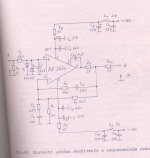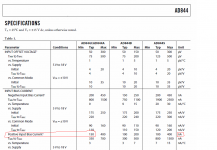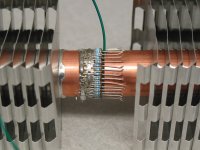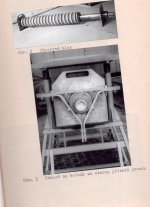AD844 bias current are very high unfortunately.
Not that bad for +IN.
Most of us share the same opinions, those who listen, of course. '-) Charles Hansen told me about the 844, but I never tried it. I just stay with discrete if I can.
You might remember I was recommending it 10 years ago. I was an unknown 'some amateur' to you, that time
The 3554 is an old hybrid voltage feedback amp: http://www.datasheetcatalog.org/datasheet/BurrBrown/mXyzywq.pdf
I was using the 3554 for near-to-zero current measurements of circuit breakers. The FB circuit contains squirrel cage shunt frequency compensation. Rshunt = 0.001 ohm. This schematic is 30 years old now.
Attachments
Not that bad for +IN.
Its the positive bias current thats on the high side.
Its the positive bias current thats on the high side.
Really? Where did you get it. 150nA.
Attachments
I wonder why no Opamp maker had the idea to design a current feedback model with a differential input added. Even if unused, it will reduce PSSR.AD844 bias current are very high unfortunately.
That is what i have done in my power amp.
Interesting, thanks.My guess is the cable is doing this:
Ayrton-Perry winding - Wikipedia, the free encyclopedia
(The double orthogonal spiral cable mentioned by Dick Marsh that is.)
wrinkle
No matter what is happening there, all they've done is remove the solenoidal component of the two spirals. They have not cancelled out the linear path length inductance. That requires the return current be in the same space.
This technique is useful (bifilar as well) when you need to put 10 pounds of wire into a 1 pound box.
Thanks. I note you did not go under 1Mhz, I guess you were answering the >10mHz comment.again with the lumped TL sim - added 84 Ohm spice lossless tline element, trimmed the delay param to 28 ns for OK match with my previous sim 12' Pass 18 awg zip cord speaker cable model
stepped termination R = 1, 84 and 1k Ohm - plotted Vsoucre V/I = impedance at driving end
sure looks like the lumped model shows some transmission line characteristics - to well over 10 MHz
the lumped model pulse waveform has some major features differing with short, open end, but the terminated rise time is delayed by the the same 28 ns that makes the Z plot match (pulse start delayed 10ns)
won't show multimode behavior - but do we need it for loudspeaker cable
I must say I'm not at all sure about where the 28 ns delay number comes from - I would have guessed 12' of not exotic Z cable delay ~18 ns I suppose I could look for the equations...
I note on the left the lines are asymptotically approaching something. What happens at 1Khz?
I also Q..are you displaying the amp nodes?
I was using the 3554 for near-to-zero current measurements of circuit breakers. The FB circuit contains squirrel cage shunt frequency compensation. Rshunt = 0.001 ohm. This schematic is 30 years old now.
Squirrel cage? Is this what you mean?
In this resistor, the current comes from the right, through all the resistors in parallel, then returns through the wires inbetween the resistors. At the last moment, the wires bend inward radially, they are already soldered here to a slightly smaller tube inside the right tube, and the current exits coaxially on the right.
jn
Attachments
Last edited:
Why no to share, if you don't make business with your 'secret' ? And even there, patents exists to protect you. Knowledge is a gift of the humanity. it has beeen given to you. The least you can do is to give-back what you have improved or discovered from it.but there are things I know that I don't want to share. Logically, the experts know much more and may only want to share what is already in public domain
During middle age, knowledge was kept in secret inside organizations (monks and "compagnons"). Result ? 1000 years with near 0 Progress.
The foundation of Internet is to share the knowledge.
Last edited:
We still talk abut Jim B's visit because he couldn't believe it was designed by a "girl".I like the AD825. It sounds 'right'.
? Somebody with no brain believing girls are made the same way ?We still talk abut Jim B's visit because he couldn't believe it was designed by a "girl".
Scott, any comment about my question: "Current feedback model with a differential input added" .
Last edited:
It must be stated that there is NO one 'best' op amp, of course, for audio
Each type of application may take a different type of op amp, and then you have to choose the 'best' of a category with certain necessary characteristics.
These include extra low noise, high source impedance drive (like an input pot), low input current, high current drive, extra fast, extra trimmed, mini-dip, single, dual, or quad, etc.
So, if for example, note the AD825. People will say: fast, known to sound 'good', fet input, reasonable output current driver.
Critics will say: Too expensive, too noisy, won't drive headphones without extra current drive, etc.
Of course, both people are 'right', but for a LINE AMP, the AD825 fits pretty well.
However, for a phono preamp, it is a lousy choice, BECAUSE it is too darn noisy.
Then, we look toward the AD797, a similar topology, but very quiet bipolar input, or something similar from another vendor. 1nV/rt Hz is necessary for phono input.
Now, what about instrumentation?
Here is where that AD797 excels! With Scott's patented extra connection, the audio frequency distortion can drop to virtually zero levels, for all practical purposes. AND that is what I have been using in the 'front end' of my ST1700B for the last 15 years, after either Scott or Walt sent me some.
However, for a second stage and working input impedances over 1Kohm, the AD797 is not the optimum device. Then a jfet input op amp is usually better. That is why I often use an OPA 134. It is reasonably quiet, has reasonably low input offset, comes in mini-dip, reasonably fast, reasonably low distortion, reasonably good drive current, reasonably high power supply voltages, etc., and reasonably inexpensive.
Kind of like a Honda. Not the best at anything, but pretty good, all around.
So where does discrete design come in, in today's audio electronics?
Well, like a super car takes a super engine, etc, so 'super' audio electronics takes discrete devices to achieve yet another level of performance.
It might not be: static distortion, but it might be: more output swing, lower input noise (0.3-0.4 nV/rt Hz is easily possible) or true balanced input to output , more output current, or that illusive thing called 'extra good sounding', that is so controversial, even here on this thread.
This is why I generally use discrete designs for my 'best' efforts, even today.
Each type of application may take a different type of op amp, and then you have to choose the 'best' of a category with certain necessary characteristics.
These include extra low noise, high source impedance drive (like an input pot), low input current, high current drive, extra fast, extra trimmed, mini-dip, single, dual, or quad, etc.
So, if for example, note the AD825. People will say: fast, known to sound 'good', fet input, reasonable output current driver.
Critics will say: Too expensive, too noisy, won't drive headphones without extra current drive, etc.
Of course, both people are 'right', but for a LINE AMP, the AD825 fits pretty well.
However, for a phono preamp, it is a lousy choice, BECAUSE it is too darn noisy.
Then, we look toward the AD797, a similar topology, but very quiet bipolar input, or something similar from another vendor. 1nV/rt Hz is necessary for phono input.
Now, what about instrumentation?
Here is where that AD797 excels! With Scott's patented extra connection, the audio frequency distortion can drop to virtually zero levels, for all practical purposes. AND that is what I have been using in the 'front end' of my ST1700B for the last 15 years, after either Scott or Walt sent me some.
However, for a second stage and working input impedances over 1Kohm, the AD797 is not the optimum device. Then a jfet input op amp is usually better. That is why I often use an OPA 134. It is reasonably quiet, has reasonably low input offset, comes in mini-dip, reasonably fast, reasonably low distortion, reasonably good drive current, reasonably high power supply voltages, etc., and reasonably inexpensive.
Kind of like a Honda. Not the best at anything, but pretty good, all around.
So where does discrete design come in, in today's audio electronics?
Well, like a super car takes a super engine, etc, so 'super' audio electronics takes discrete devices to achieve yet another level of performance.
It might not be: static distortion, but it might be: more output swing, lower input noise (0.3-0.4 nV/rt Hz is easily possible) or true balanced input to output , more output current, or that illusive thing called 'extra good sounding', that is so controversial, even here on this thread.
This is why I generally use discrete designs for my 'best' efforts, even today.
Jim B. is a very smart guy. He is just 'prejudiced' against women. It comes from his early background and his emulating a sort of a Sicilian 'gangster'. He has gotten into far worse trouble over women than some casual comment about the lady designer at AD. By the way, she is really smart too. I wish I knew her better, but we only met once, and do not cross the same paths. How is she, Scott? Say hello for me, although she might not remember meeting me at one of the AD conferences, perhaps 10 years ago.
Last edited:
Really? Where did you get it. 150nA.
150nA is high - that's one of the draw backs of the 5532/34 (200nA typical).
You cannot direct couple to a volume control put because you get scratching sounds as you rotate the pot.
JFET opamps are great for this, but the LM4562 is also good at 10nA (typ) although input bias does rise with input common mode voltage.
A switched attenuator is the solution for high input bias opamps - yo cn then direct couple but the problem is they are expensive.
I don't know him, John, it was just a joke about equal rights: "Somebody with no brain believing girls are made the same way".Jim B. is a very smart guy.
About choosing an OPamp, it is always a hard work. We always need half of this one, half of that one
And when we have one favorite, it is immediately out of production.
Last edited:
"precision CFA" wasn't immediately popular - the AD846 didn't last long - presumably no one bought it
I only used it in a few circuits in a R&D effort/prototype that didn't become a product
there are "CFA derived" VFA that put a (~ diamond) buffer in front of the (now fixed, internal) rx and the -in LM6171 is one example
I only used it in a few circuits in a R&D effort/prototype that didn't become a product
there are "CFA derived" VFA that put a (~ diamond) buffer in front of the (now fixed, internal) rx and the -in LM6171 is one example
Squirrel cage? Is this what you mean?
jn
Attached is the photo of the 63kA (for up to 20 periods of 50Hz shrt circt current) shunt with which the 3554 amp was used. Top photo is a squirrel cage, this was inside coaxial cylindrical return. BW: 0 - 2MHz.
Cheers,
Attachments
- Status
- Not open for further replies.
- Home
- Member Areas
- The Lounge
- John Curl's Blowtorch preamplifier part II



